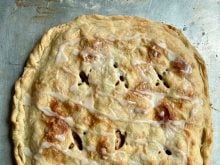At a summertime playground event in our community, our grandchildren enjoyed making this Goop. Of course they wanted to try it again, so off to the store we went to get the ingredients. This time food colouring was added to this Play Dough type of modelling clay.
Goop
1 cup distilled water 250 mL
1 1/2 cups Lepages 350 mL
white glue
1/4 cup Borax 40-50 mL
Mix half the water with all the glue. Mix the other half of the water with the Borax. Pour the Borax mixture into the glue mixture. Knead until soft. You may need to add more water to make the mixture soft and runny.
Read Also

Support needed at all levels for high-value solar projects
Farmers, rural municipalities and governments should welcome any opportunity to get involved in large-scale solar power installations, say agrivoltaics proponents.
If stored in a closed container or plastic bag, it will remain goopy for a couple of months. If hardened, you can reconstitute with additional water.
Time to water the garden?
Recently a friend was watching a TV program on gardening that said not to water the garden at night because it could cause a fungus problem. I wondered if this could be so in our dry prairie climate, so I phoned the University of Saskatchewan Garden Line.
The reply was, “in dry Saskatchewan we usually don’t need to worry about fungal problems but it is a good rule of thumb to water in the early a.m. instead of the evening or night.”
A horticulturist friend said the best time to water lawns, roses and other garden plants is from 4 to 7 a.m. The roots will become wet and the sun will come out to dry the leaves, helping to prevent moisture-loving diseases. Also, less water will be lost to evaporation than if watering during the day.
The problem, unless you have an automatic timer, is getting up that early in the morning to turn on the water.
New nutrition labelling
In June 2001, new and improved regulations for nutrition labelling were presented by health minister Allan Rock.
To see a copy of the proposed changes, contact Health Canada at www.hc-sc.gc.ca; write to 2301 Midland Ave., Scarborough, Ont. M1P 4R7, 416-973-1447, fax: 416-973-7794.
The minister is requesting consumer feedback until Sept. 14, after which the proposed regulations will be evaluated in light of the comments received, to determine if changes are needed.
Food safety
In a study commissioned by the Canadian Food Inspection Agency, less than one-third of the 2,000 Canadians interviewed said they needed more information on the proper ways to cook, store and handle food. But their answers to some basic questions demonstrated an ignorance that could put them at risk. Did you know?
- You can’t tell if a food is safe to eat by just smelling it.
- Food-borne illness can occur 30 minutes, two weeks or even longer after eating food containing harmful bacteria or the toxin produced. No wonder people mistake it for the flu.
- The 10 most likely foods to cause illness, starting with most likely, are: mixed dishes (casseroles, sandwiches, burritos); greens and vegetable salads; turkey; fruits and vegetables; beef; fish; juices and beverages; eggs; protein salad; and ham.
- Freezing doesn’t kill microorganisms; it just halts their growth.
- Pets carry microorganisms that could spoil food. Be sure you wash your hands after petting animals and don’t let the cat onto the kitchen counter. Also, remember your pets or wild animals may have been in your vegetable garden, so always wash fresh produce before eating.
- Just because a beef patty looks done, it doesn’t mean it has reached the safe temperature of 160 F (70 C) required to kill bacteria. Use a clean meat thermometer to be sure.
- Steaks and roasts can safely be enjoyed rare, provided the exterior surfaces are cooked. That’s because bacteria exist only on the surface of the meat. Rolled steaks and roasts, and mechanically tenderized meat should be cooked to medium (160 F/70 C).
Source: Beef Information Centre.
The Beef Information Centre is one of the founding members of the Canadian Partnership for Consumer Food Safety Education. Today, more than 60 industry, consumer and government organizations collaborate on programs to educate consumers on the actions they can take to reduce food-borne illness in Canada. To learn more, visit the website at www.canfightbac.org.
For specific information on the safe handling and storing meat and poultry products, request the Chill Out brochure by calling the Beef Information Centre, 888-248-BEEF or by ordering directly from www.beefinfo.org.
Amish friendship bread
A recipe for Amish Cinnamon Bread was printed in our July 12th column. Since then, we have had several requests for the starter recipe that is used in making this bread. It follows, along with the bread recipe repeated.
The idea behind a friendship cake or bread is a mixture of flour, sugar and liquid that has been allowed to ferment. The starter is allowed to grow for several days but to keep the yeast alive it must be fed regularly. Once the quantity of starter is at least two cups, it can be split and used to make a cake or bread, or given to someone else to feed and grow for their own use.
Starter Recipe
1 package active dry yeast
21/2 cups warm water 625 mL
2 cups sifted flour 500 mL
1 tablespoon sugar 15 mL
Dissolve yeast in 1/2 cup (125 mL) of the warm water in a deep glass or plastic container. Stir in remaining warm water, flour and sugar. Beat until smooth. Cover with loose fitting cover. Do not refrigerate.
The starter requires 10 days for fermentation as follows:
Days 1, 2, 3 and 4: Each day stir the batter with a wooden spoon.
Day 5: Add 1 cup (250 mL) each flour, sugar, milk. Mix well.
Days 6 and 7: Stir batter each day.
Days 8 and 9: Do nothing.
Day 10: Add 1 cup (250 mL) each flour, sugar, milk. Mix well.
(Day 10 becomes Day 1 for the next series.)
This makes three cups (750 mL) batter to use in one of the following ways:
- Use one cup in the following recipe.
- Pour 1/2 cup (125 mL) batter into three glass or plastic containers of four-cup (1 L) size and give away to three friends.
- Save 1/2 cup (125 mL) to begin process all over again and to restart your batch. It can be frozen but takes at least 24 hours at room temperature to thaw and come to life.
Amish Cinnamon Bread
Place one cup (250 mL) of starter in a large bowl and add the following:
1 cup oil 250 mL
1 cup sugar 250 mL
4 eggs
2 teaspoons vanilla 10 mL
2 cups flour 500 mL
1 teaspoon baking 5 mL
powder
1 teaspoon baking soda 5 mL
1 small package vanilla
instant pudding mix, or
butterscotch
In a small bowl combine:
3 teaspoons cinnamon 15 mL
1/2 cup brown sugar 125 mL
Grease two large loaf pans. Put quarter batter in each. Sprinkle quarter of the sugar mixture on top of each, then top with the remaining batter.
Sprinkle with remaining sugar mixture. Swirl with a knife to marble.
Bake at 325 F (160 C) for 45 to 60 minutes. It also works to use two
9 x 9 inch (22 cm) square cake pans.
Raspberry recipe found
Dear TEAM: Last summer there was a request for a raspberry topping. I have been making this recipe since 1983 when I clipped it from The Western Producer. – O.G., Leslie, Sask.
Raspberry Topping
10 cups raspberries 2.5 L
5 cups water 1.25 L
Let fruit and water boil for 45 minutes. Put the mixture in a thin cloth bag so the juice will run through. When it has stopped dripping, squeeze the cloth and mixture to get all the juice out of the pulp.
Then measure the juice. For every cup of juice measure a cup of sugar into a separate container. Note: Do not mix together until later.
Boil the juice for 30 to 40 minutes. While it’s boiling, skim off the foam that comes up with a metal spoon.
Add the sugar all at once and stir constantly until it is dissolved. Do not boil it any more.
Fill jars with the hot syrup and seal. Use as a topping for ice cream or fancy desserts.














